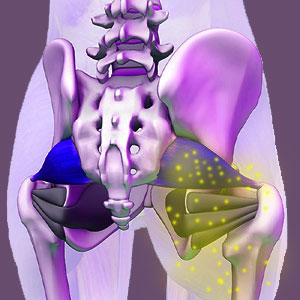
Piriformis tingling describes symptoms in the buttocks, legs or feet that are not painful, but feel as if the nerves are not functioning correctly. Tingling, also called pins and needles, is a very common symptom of pseudo-sciatica, as well as spinally-motivated sciatica. It is also one of the major expressions of piriformis syndrome.
Tingling sensations are not generally disturbing enough to warrant medical attention for many people. However, in combination with numbness, pain, weakness or motor dysfunction, tingling is yet another burden to bear and should be investigated by a qualified medical practitioner.
This discussion focuses on explaining tingling sensations caused by piriformis-enacted nerve compression. We will detail the locations and expression of symptoms, the underlying cause of tingling and why this symptom should be taken very seriously, even if it is not overly severe.
Piriformis Tingling Symptomology
Tingling is a feeling of disturbing intermittent nerve signal, often known as pins and needles. The sensation is not painful in a classic sense, but is frightening and can prevent patients from performing athletically, concentrating or sleeping well in some circumstances.
In association with a piriformis syndrome diagnosis, tingling can occur in the hip region, in the buttocks, in the legs or in the feet. Most patients will experience symptoms in multiple locations. Furthermore, symptoms may be unilateral or bilateral in presentation.
Most piriformis symptoms, including tingling, are variable in nature and not specifically patterned. This means that the majority of patients will experience symptoms in different locations, of different severity and possibly even of different expression. Less commonly, patients might have more predictable tingling in specific areas, as well as from specific activities or positions.
Piriformis Tingling Causes
Tingling sensations can occur due to circulatory or neurological issues, often involving a reduction of blood flow or compression of a nerve tissue. Tingling might not point to full neurological compression, since some degree of signal is still traversing the nerve. This is why it is such a common manifestation in piriformis syndrome, since the sciatic nerve is often not compressed to the degree of full dysfunction.
Alternative explanations for tingling in the lower body may involve localized nerve compression (which should produce very predictable symptoms in a limited area), diabetes, ischemia, obesity, spinally-motivated sciatica, cervical spinal stenosis, neuromuscular disease or other sources. This is why full diagnostic evaluation should be handled by an expert neurologist for best results.
Patients should be wary that many cases of sciatica tingling are blamed on incidental and innocent lumbar spinal abnormalities, like herniated discs. While these irregularities can be the source, they rarely are, explaining why most spinal surgeries fail terribly.
Piriformis Tingling Cautions
Statistically, tingling is often one of the preliminary expressions of piriformis syndrome. In most cases, tingling will evolve quickly to include pain, numbness and weakness in affected regions. Some patients may also begin to demonstrate functional deficits, such as foot drop. In less common scenarios, more significant symptoms might follow, such as incontinence and/or sexual dysfunction, depending on which tissues are actually affected and the mechanism of symptomatic causation.
If you are currently experiencing tingling, now is the time to get it checked out. Do not wait for worse expressions to follow, since early diagnosis and treatment can improve therapeutic outcomes in most patients and prevent many of the collateral consequences of debilitating pain that might soon follow.





